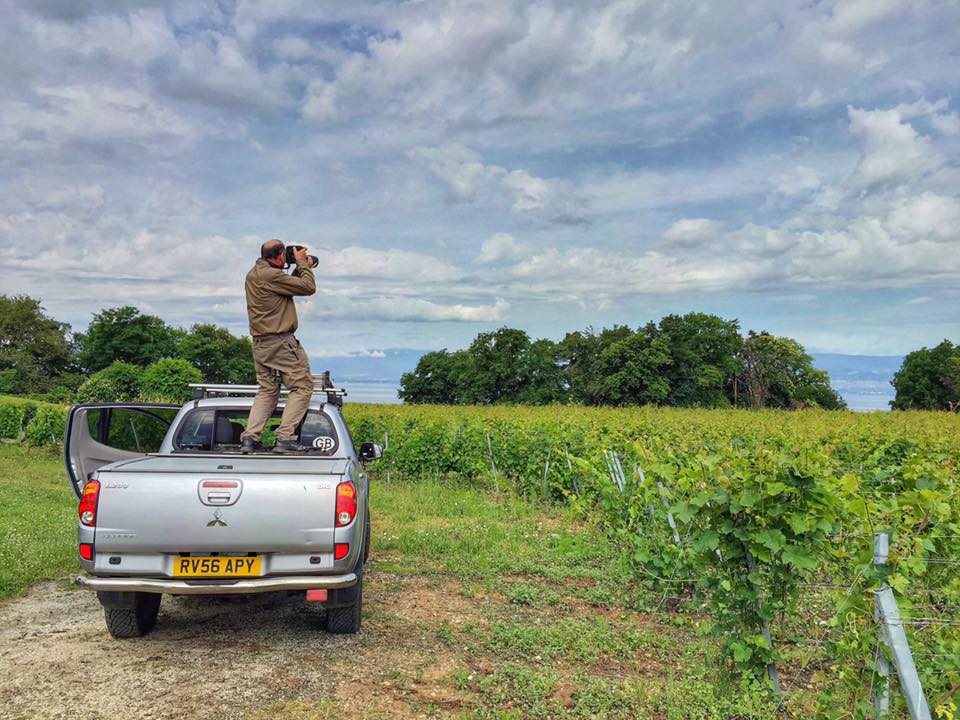Mick Rock has been photographing wine for three decades and is one of the wine industry’s most important sources for wine photography with his company Cephas. Amanda Barnes interviews him to find out about some of his early adventures in wine (including covering 10,000 miles in seven weeks in a 4×4) and his plans for the future — which include one very special butterfly.
What’s your earliest memory in wine?
Corrida and Hirondelle were my tipples of choice before meeting Annie, my French wife-to-be. But then her family started to introduce me to good value Bordeaux, Burgundy, Alsace, etc. and thankfully I could tell the difference. In 1985, we went to a family wedding in the Dordogne and, whilst there, we also took the opportunity to visit Bergerac, St-Émilion and Pomerol, and then Muscadet on the drive back home. This gave me my first opportunity to seriously photograph wine, and also taste it on location.
You’ve been photographing wine subjects since 1985, please correct me if I’m wrong! How have you seen the world of wine photography change in that time?
Before 1985, I had only been shooting on 35mm film. It was then that I made the very important decision to invest in a Mamiya 6×7 system. This was not only heavy and expensive, but also meant much higher film costs with there being just ten photos per roll of film. However, it was probably the best decision I ever made. In those pre-digital days, large batches of transparencies were sent out to clients all over the world by post or courier. The quality of 6x7cm images, over four-times the size of 35mm, always made a big impact on picture editors.
Nowadays that has all changed as photos are chosen from our website, often to be used on websites where size is not such an issue. However, an image printed large in a magazine or book will still show up any limitations in quality and it is gratifying to see many of my older film photos still being regularly used. Now, however, all my new shooting is digital and I enjoy the extra flexibility that it allows, as well as being far easier on my back.
Do you have any favourite subjects or regions to shoot? And why?
I am very fortunate to have travelled to so many beautiful wine regions of the world. However, there is something special about having first visited small areas, such as Priorat, in 1987, and Jura, in 1986, before they became more widely known. These remain two of my many favourites.
Tell us about the development of Cephas and its role within the industry…
Annie’s family had a cottage in the Marne Valley, on the western fringe of Champagne. Publishers’ interest in photos from there, and also from the Dordogne trip, made me think that wine could be a niche subject which hadn’t been fully exploited. I had previously just been a general photographer and the idea of such a fascinating specialism really appealed, so we established Cephas Picture Library in 1985. This led to us taking a three-week camping trip in 1986, around Northeast France at harvest time. The timing was fortuitous as, in 1987, Salamander Books decided to publish the first two volumes in their Classic Wines of the World series: The Red Wines of France and The White Wines of France. Joanna Simon was to be the Consultant Editor and she put my name forward for photography.
These were successful and led to Spain & Portugal and then Italy: not having any photos from these countries meant that another trip was necessary. A 4×4 car was bought, in which it was possible to sleep, and we headed off on a mammoth journey during the harvest of 1987. This took in most of their wine regions and we covered 10,000 miles in seven weeks. Following on from these, The Wines of The Americas was to be published in 1990, so two trips were planned there. First to the west coast of the USA during the harvest of 1988, and then to the east coast in the spring of 1989. It was during this time that Oz Clarke’s New Classic Wines was mooted, so in 1990, a round-the-world trip to Australia and New Zealand was undertaken, finishing off with a few days in the Napa Valley. We returned from this with 550 rolls of exposed film, carried as hand baggage, and having managed to avoid it being X-rayed on all the flights taken.
Following this, our next major trip was a fascinating five-week drive to Greece and the newly-opened Bulgaria, Romania and Hungary, during the harvest of 1991.
By this time Cephas had become the go-to source for wine photos of the world, and I was very honoured to be included in a Decanter list of ‘The Top Movers and Shakers in the UK Wine Scene’. Since then, I have also brought other wine photographers into the Cephas fold to expand our archives from around the world.
Do you have any interesting projects in the pipeline at the moment or anything recent you’d like to share?
Drones are playing a major part in my photography nowadays. I gained CAA permission in 2019 and since then have delighted in showcasing the beauty of our British vineyards from the air. This is a significant and ongoing project. It’s incredible to see all the vineyards now in a region such as the Crouch Valley, where I used to cycle regularly as a lad, living in Essex during the 60s and early 70s.
When you aren’t shooting or drinking wine, what do you like to do to relax?
Butterflies are my hobby, and I have photographed all except one of our native species. I hope to rectify that in August during a trip to Cumbria. I also record them here in Surrey for Butterfly Conservation and the UK Butterfly Monitoring Scheme.
Featured photo of Mick taken by Brett Jones.

